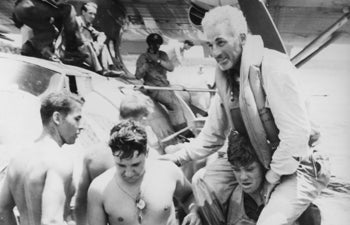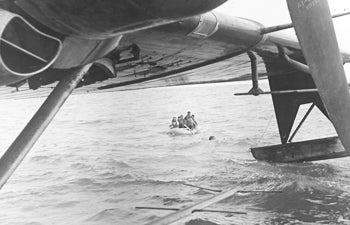True Tales of Survival
Buoyed by only a life vest, the young American pilot bounced and bobbed in the cold, dark waters of the Pacific Ocean. Forced to abandon his aircraft earlier that afternoon after it was shot down by Japanese destroyers, it was now the middle of the night. Surrounded by blackness, he was unsure of his exact position. In the distance, occasional flashes from artillery fire lit up the night sky.
Just after sunrise, foamy phosphorescent waves began to bubble up as a destroyer bore down on him. He was so close to the vessel he could make out the American sailors on deck. His lips to a whistle around his neck, he blew. The men were alerted and plucked him to safety.
It was 1942 and the young airman had been wading in Philippine waters smack in the middle of the Battle of Leyte Gulf, now regarded as the largest and most intense naval battle of World War II.
That man’s name may be lost to history, but the story of his heroic survival is now captured in Douglas Keeney’s forthcoming book Lost in the Pacific: Epic Firsthand Accounts of WWII Survival Against Impossible Odds (FastPencil PREMIERE). The book, due out in April, recounts 23 narratives of enlisted American men who endured plane crashes, being shot down or having to ditch their aircrafts in the Pacific Ocean. A number of men floated for days in open waters before their rescues.
Keeney, who earned a bachelor’s degree in economics from USC Dornsife in 1973 and an MBA from the USC Marshall School of Business in 1976, came upon these true tales of heroism while digging through the archives of Maxwell Air Force Base’s History Center in Montgomery, Ala.

Gen. Nathan F. Twining, Commanding General of the 13th Air Force in the Pacific, was lost at sea for six days during World War II. As the highest ranking officer to ditch in the Pacific, an all-out search was mounted for him because of the vital secrets that he knew. Following the war he became Secretary of the Air Force and, later, under President Dwight D. Eisenhower, Chairman of the Joint Chiefs of Staff. Photo courtesy of Lost in the Pacific/National Archives.
Scanning through nearly 2,000 feet of microfilm, the historian couldn’t help feeling that each story of survival he encountered — collected in crash reports made by the army and navy — embodied the moral fiber of America.
“I felt like I was looking at ground zero for the DNA that courses through every rescuer, every first responder, every man or woman that went up the stairs on September 11 in the World Trade Center,” Keeney said.
Keeney, himself a pilot, is fascinated by World War II history, exemplified by the roster of his works of historical non-fiction. He has authored or co-authored more than a dozen books, which examine events such as D-Day and the Cold War.
He traces his interest in history to his childhood when he would dig through his grandmother’s attic for entertainment. Rummaging through boxes, he found plates and glassware wrapped in newspapers chronicling the events of WWII.
“I was captivated by the stories of war. I would haul the papers home and put them between books to get the wrinkles out,” Keeney said.
Later, as a USC Dornsife student he was inspired by trips to the El Toro Marine Corps Air Station near Irvine, Calif., where he and his friends would watch jets land.
“I’ve often thought of that as where I got my interest in aviation history and military histories,” Keeney said.
As an undergraduate, Keeney not only found a lifelong passion for learning, he also found his lifelong partner. On the first day of his freshman year he was seated alphabetically next to Jill Johnson (comparative literature ’73), and the two were married a year and a half after graduation.

After six days lost at sea, U.S. Air Force Gen. Nathan F. Twining and his men were spotted in a raft. Because there wasn’t enough room aboard the raft, one man was forced to float in the water. Photo courtesy of Lost in the Pacific/National Archives.
After Keeney earned his MBA from the USC Marshall School of Business, he and Jill, a journalist, moved to New York City. There, Keeney had a successful 16-year career in advertising with the firm Ogilvy & Mather, a job that began with an internship arranged through USC Marshall. From there, he went on to found Douglas Keeney & Company, a publishing and production company that would create content for cable television networks and book packaging for New York publishers. In 1992, he cofounded The Military Channel with two other partners.
He began writing around that time, often visiting archives. The stories that he uncovered would become the basis of his books.
“I will go through an archive wherever I can get into one, whether it’s on an air force base, the USC archives, or a national archive in Washington, D.C.,” Keeney said. “It’s a very solitary thing to do, but it’s a happy thing for me.”
Keeney credits his liberal arts education at USC Dornsife for preparing him for a career in writing by giving him a broad understanding of the world.
“I took classes in oceanography, philosophy, economics,” Keeney said. “By ranging out into these other fields, I prepared myself for opportunities that I couldn’t have imagined. Having a diverse undergraduate education pays off so beautifully when we get specialized later in our adult life.”
In particular, a light bulb went on in his head when a philosophy course at USC Dornsife introduced him to the writings of humanists Erich Fromm and Viktor Frankl.
“Learning about the value and strength of the human changed everything,” Keeney said. “You can see it in Lost in the Pacific. That’s what resonates in these stories — this very concept that we have compassion for each other and we’ll help each other.
“I say to people that I got it all at USC. I got my education, I got an internship that led to my career and I found my wife there. That’s the trifecta. It doesn’t get any better than that.”